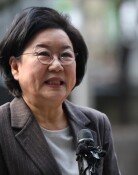Gasoline Prices Differ by 283 Won per Liter
Gasoline Prices Differ by 283 Won per Liter
Posted August. 30, 2007 06:08,
Although the price of gasoline in Korea has increased an average of 4.2 percent nationwide in 2006 from a year ago, the rates of increase differed up to four times depending on region, ranging from a high of 6.9 percent to a low of 1.8 percent.
Although the nations average gasoline price was 1,492.43 won per liter, it was sold at a high of 1,723 won per liter in Ulleung-gun, North Gyeonggi Province, and at a low of 1,440 won per liter in Goesan-gun, North Chungcheong Province, showing a difference of 283 won.
The disparity in gasoline price increase rates among the regions continued this year. Gasoline prices increased nearly twofold in some parts of the country between the first week of January and the first week of August.
Although local oil companies claim that the price of gasoline should be different according to region due to differences in land, labor and transport costs, some experts point out that the price difference is largely caused by the distribution of bogus gasoline in some regions and by refining companies which sell gasoline at different rates depending on the region.
Among the 234 regions surveyed, the increase was the highest in Gyeongsan-si, North Gyeongbuk Province at 6.9 percent, and the lowest in Paju-si, Gyeonggi Province at 1.8 percent, according to Regional Oil Prices between 2005 and 2006, a joint report by the Ministry of the Commerce, Industry and Energy and the Korea National Oil Corporation (KNOC).
The nations average price of gasoline was 1,432.64 won per liter in 2005, up 4.2 percent from 1,492.89 won from a year earlier. The price dropped to 1,422.08 won in the first quarter of this year, but quickly jumped to 1,531.75 won in the second quarter.
Cities and provinces which had the greatest deviations in oil price increases were Seoul (Do Dong-gu 5.6 percent, Songpa-gu 2.2 percent), Incheon (Gyeyang-gu 4.9 percent, Nam-gu 1.8 percent), Gyeonggi Province (Goyang-si 5.8 percent, Parju-si 1.8 percent), Gangwon (Samcheok-si 5.3 percent, Chuncheon-si 2.5 percent) and South Jeolla Province (Jindo-gu 5.9 percent, Hwasoon-gun 2.1 percent)
The price was the highest in Ulleung-gun, where the transportation cost of gasoline was the highest at 1,723 won per liter, and the lowest was in Goesan-gun at 1,440 won. Given that the land price and the rent, and labor costs differ by region, it is natural that gas and diesel prices vary according to region, an official of an oil refiner said. In areas where the competition between gas stations is fierce or many gas stations are found, the price of oil tends to be lower than other areas, said Joo Jung-bin, a senior official at the Korea Petroleum Association.
Not only the prices of oil products but also their price increase rates are lower in regions where cheap bogus gasoline products are easily found, another official said. Another reason for the regional differences in oil prices is the refiners which apply different rates when supplying oil products to gas stations.
The KNOCs data on prices at gas stations are based on a survey where representative gas stations of each administrative district are asked each week about their gas and petroleum prices.
The KNOC, which has released its data on the prices of oil in 16 cities, has yet to release data classified by ward and county. The report, which is also used in calculating the prices of commodities by the National Statistical Office, is the only official data that the government collects on the price of domestic oil.







